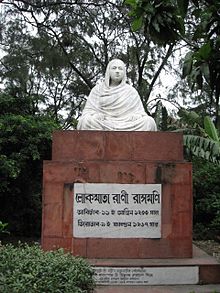Rashmoni Das | |
|---|---|
 Statue of Rani Rashmoni at Esplanade, Kolkata | |
| Born | 28 September 1793 Kona village, Bengal Presidency ( adjacent to Halisahar-Kanchrapara; her ancestral land is marked by a ghat and temple in CharNandanbati, Kalyani thana, Nadia) |
| Died | 19 February 1861 (aged 67) |
| Nationality | Indian |
| Other names | Rani Rashmoni, Lokmata |
| Occupation(s) | Social activist, Businessperson, Zamindar |
| Known for | Founder of Dakshineshwar Kali Temple in Kolkata |
| Spouse | Babu Rajachandra Das (Marh) |
| Children | Padmamoni Das (Ata), Kumari Chowdhury, Karunamoyee Biswas, Jagadamba Biswas.[1] |
Rashmoni Das, popularly known as Lokamata Rani Rashmoni, also spelled as Rani Rasmani, (28 September 1793 – 19 February 1861), was an Indian businesswoman, entrepreneur, Zamindar, philanthropist and the founder of the Dakshineswar Kali Temple in Kolkata. She remained closely associated with Sri Ramakrishna Paramhansa after she appointed him as the priest of the Dakshineswar temple. She was also one of the earliest social reformers in early nineteenth-century Bengal and was one of the forerunners of the Bengal Renaissance. Besides, she also led many of the resistances against the encroaching British administration and their presence in all walks of colonial society in the Bengal province. Her other construction works include the construction of a road from Subarnarekha River to Puri for the pilgrims, Babughat (also known as Babu Rajchandra Das Ghat), Ahiritola Ghat and Nimtala ghat for the everyday bathers at the Ganges. She also offered considerable charity to the Imperial Library (now the National Library of India), and the Hindu College (now Presidency University).[2]
Presently, the Lokmata Rani Rashmoni Mission is situated at Nimpith, South 24 Parganas, West Bengal, 743338, India.[3]
- ^ Roy, Nirmal Kumar, "Rani Rashmonir Jibanvritanta" (Life History of Rani Rashmoni), Udbodhan, 1, Udbodhan Lane, Bagbazar, Kolkata - 700 003. ISBN 81-8040-345-9. pp. 196-232
- ^ Rashmoni Devi Dakshineswar Kali Temple website.
- ^ NGO's working with Environment Department Archived 31 January 2009 at the Wayback Machine Environment Department, Government of West Bengal.